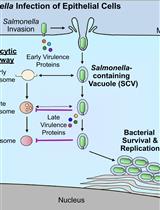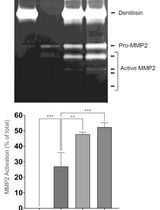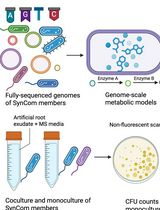- EN - English
- CN - 中文
Quantification of Bacterial Twitching Motility in Dense Colonies Using Transmitted Light Microscopy and Computational Image Analysis
利用透射光学显微镜技术和计算机图像定量分析密集菌落中的细菌蹭行运动
发布: 2018年04月20日第8卷第8期 DOI: 10.21769/BioProtoc.2804 浏览次数: 7102
评审: Andrea PuharTimo A LehtiAlexander B Westbye

相关实验方案

细菌病原体介导的宿主向溶酶体运输的抑制:基于荧光显微镜的DQ-Red BSA分析
Mădălina Mocăniță [...] Vanessa M. D'Costa
2024年03月05日 2049 阅读

通过制备连续聚丙烯酰胺凝胶电泳和凝胶酶谱分析法纯化来自梭状龋齿螺旋体的天然Dentilisin复合物及其功能分析
Pachiyappan Kamarajan [...] Yvonne L. Kapila
2024年04月05日 1385 阅读
Abstract
A method was developed to allow the quantification and mapping of relative bacterial twitching motility in dense samples, where tracking of individual bacteria was not feasible. In this approach, movies of bacterial films were acquired using differential interference contrast microscopy (DIC), and bacterial motility was then indirectly quantified by the degree to which the bacteria modulated the intensity of light in the field-of-view over time. This allowed the mapping of areas of relatively high and low motility within a single field-of-view, and comparison of the total distribution of motility between samples.
Keywords: Bacteria (细菌)Background
Pilus-mediated twitching motility represents a form of surface-associated bacterial movement that is independent of flagella. Twitching motility is utilized by many bacterial pathogens, including Neisseria gonorrhoeae and Pseudomonas aeruginosa, to interact with moist surfaces and translocate epithelial barriers. In P. aeruginosa, twitching motility is regulated by a large number of genes which allow both extension and retraction of type IV pili to effectively drag the bacterial cell across any given surface in response to environmental cues (Mattick, 2002; Whitchurch et al., 2004; Burrows, 2005). In our studies of P. aeruginosa pathogenesis, twitching motility contributes to bacterial exit from epithelial cells after internalization and bacterial traversal of multilayered corneal epithelia (Alarcon et al., 2009). In a murine model of corneal infection, twitching motility was important for P. aeruginosa virulence (Zolfaghar et al., 2003). Recently, we discovered that the glycoprotein DMBT1 found in mucosal fluids such as human tears and saliva was capable of inhibiting P. aeruginosa twitching motility (Li et al., 2017). In that study, we utilized a novel method to quickly and robustly quantify P. aeruginosa twitching motility. That protocol is presented herein.
The most direct way to quantify twitching motility would be to track all individual bacteria over time. This method was attempted as part of our original study. However, bacterial colonies have a complex 3D structure, with bacteria regularly traversing one another, making tracking feasible only near the colony edge, resulting in sampling bias. Previous methods for quantifying twitching motility also quantified motility only at the colony edge (Alarcon et al., 2009; Semmler et al., 1999). For our study, we wished to extend those methods to be able to quantify twitching behavior throughout a dense bacterial colony. Instead of focusing on the direction of motility, we focused on quantifying the degree of motility at any given point. This turned out to be a simpler problem to solve, since as bacteria move, they modulate light as they pass through a given point. By mapping out the relative magnitudes of this modulation over time, we were able to generate maps of regions of relatively high and low motility in dense, spatially complex colonies.
Materials and Reagents
- Glass slides (Fisher Scientific, Fisherbrand, catalog number: 12-550-15 )
- Cover slip (Fisher Scientific, Fisherbrand, catalog number: 12-545M )
- Small Petri dish (Corning, Falcon®, catalog number: 351029 )
- Large Petri dish (Sigma-Aldrich, catalog number: P5981-100EA)
Manufacturer: Excel Scientific, catalog number: D-902 . - Kimwipes (KCWW, Kimberly-Clark, catalog number: 34155 )
- Inoculation loop (Fisher Scientific, Fisherbrand, catalog number: 22-363-597 )
- Sterile wooden toothpick (any brand, autoclave at 121 °C for 15 min in a foil-covered container)
- Pseudomonas aeruginosa strain MPAO1 (Dr. Manoil Laboratory, University of Washington, Seattle, WA), or other piliated strain (or bacterial species) with functional twitching motility. (MPAO1 is a wild-type P. aeruginosa strain, and is available from the University of Washington, Seattle, WA. http://www.gs.washington.edu/labs/manoil/libraryindex.htm)
- Substance to be tested in the assay (e.g., human tear fluid)
- Deionized water
- Magnesium sulfate heptahydrate (MgSO4·7H2O) (Fisher Chemical, catalog number: M63-500 )
- Gellan gum (Alfa Aesar, catalog number: J63423 )
- Tryptone (BD, BactoTM, catalog number: 211705 )
- Sodium chloride (NaCl) (Fisher Scientific, Fisher Chemical, catalog number: S271-3 )
- Yeast extract (BD, BactoTM, catalog number: 288620 )
- Trypticase Soy Agar (TSA) powder (BD, DifcoTM, catalog number: 236950 )
- Twitching medium (see Recipes)
- Trypticase Soy Agar (TSA) plate (see Recipes)
Equipment
- Tweezers (Dumont, Dumoxel Nº5, Fine Science Tools, catalog number: 11252-30 )
- Bunsen burner
- 3.60 °C oven (Boekel Scientific, model: 133000 )
- Sterile Biosafety Cabinet (NUAIRE, model: NU-425-600 )
- Compound microscope with a high NA objective and digital camera (≥ 1.2). Our study used:
- Nikon Ti-E inverted wide-field fluorescence microscope (Nikon Instruments, model: Eclipse Ti-E )
- Uno-combined controller (Okolab) and stage-top incubation chamber to maintain samples at 37 °C (Okolab, model: H301-Nikon-TI-S-ER )
- CFI Plan Apo Lambda 60x NA 1.4 oil objective (Nikon Instrument, model: CFI Plan Apochromat Lambda (λ) Series )
- DS-Qi2 Monochrome CMOS Camera (Nikon Instrument, model: DS-Qi2 )
- Nikon Ti-E inverted wide-field fluorescence microscope (Nikon Instruments, model: Eclipse Ti-E )
- Computer. MacPro5.1 (2012), 2x 2.4 GHz 6-Core Intel Zeon, 64 GB 1333 MHz DDR 3 ECC
Software
- ImageJ (version 1.51n) or FIJI (http://fiji.sc/)
- R compiler (version x64 3.4.1) (https://www.r-project.org/)
Procedure
文章信息
版权信息
© 2018 The Authors; exclusive licensee Bio-protocol LLC.
如何引用
Smith, B. E., Li, J., Metruccio, M., Wan, S., Evans, D. J. and Fleiszig, S. M. J. (2018). Quantification of Bacterial Twitching Motility in Dense Colonies Using Transmitted Light Microscopy and Computational Image Analysis. Bio-protocol 8(8): e2804. DOI: 10.21769/BioProtoc.2804.
分类
微生物学 > 微生物-宿主相互作用 > 细菌
细胞生物学 > 细胞成像 > 活细胞成像
细胞生物学 > 细胞运动 > 细胞运动性
您对这篇实验方法有问题吗?
在此处发布您的问题,我们将邀请本文作者来回答。同时,我们会将您的问题发布到Bio-protocol Exchange,以便寻求社区成员的帮助。
提问指南
+ 问题描述
写下详细的问题描述,包括所有有助于他人回答您问题的信息(例如实验过程、条件和相关图像等)。
Share
Bluesky
X
Copy link











